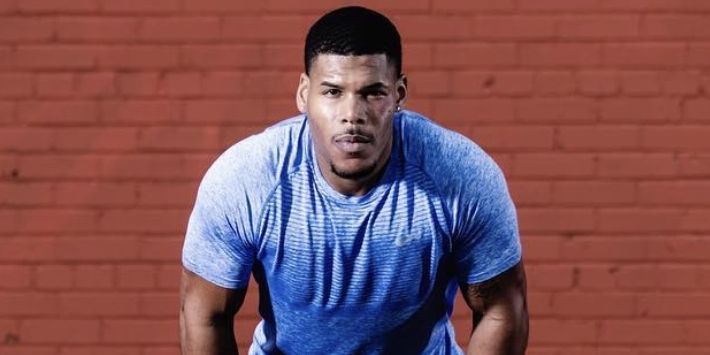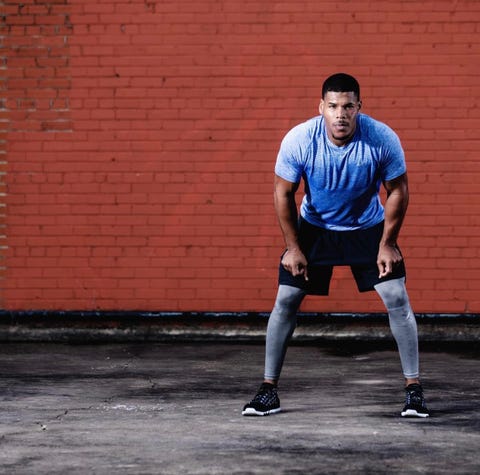While you might recognize him as the personal trainer best known for patiently tolerating—and sometimes, hilariously manhandling—Kevin Hart in YouTube’s popular ‘What the Fit,’ series, Ron ‘Boss’ Everline’s fitness credentials are no laughing matter.
In the 15-plus years since his bid to go pro in the NFL fell short, Everline has laid the foundation for a fitness empire, which now includes a brick-and-mortar facility, a training and nutrition app, a network of certified fitness coaches and specialists, and a sizable following of more than 1 million on Instagram.
At its core, Everline’s brand can be summed up with just two words: Just Train, a slogan that emblazons the merch worn by himself, his staff, and his high-profile clients. (In addition to Hart, Everline has helped sculpt the physiques of everyone from NFL linebacker Derrick Johnson to R&B artists like Ne-Yo and Trey Songz.) It’s a deceptively simple, but powerful message: Put in the work, little by little, and you’ll see results.
“This is only 45 minutes to an hour out of your day, and it’s going to make you a better person,” he says. “Give it your all so that you leave nothing on the table.” Gracious Boss that he is, Everline recently took a few moments away from managing his many ventures to help us learn how we can apply his workout wisdom in the service of our own gains.
What distinguishes your style of training from that of most other trainers?
Teamwork. I work out with most of my clients and employ gamification. I like to gamify how we work out, and adopt it as a mindset. It’s not just about the aesthetic; it’s about what we’re ultimately trying to accomplish in the gym, and in life. So I try to understand my clients’ life goals and bring them fully focused to the gym, and ready to train hard.
If I was your client and I showed up in your gym ready to train with you, what might be an example of how you would work with me to gamify the workout?
First of all, I would obviously try to understand your mindset, which we would get to during the initial consultation. I would ask questions to try to get to the heart of what you’re trying to accomplish in the gym, along with what you’re trying to accomplish in life. What I do is I bring those worlds together.
This content is imported from Instagram. You may be able to find the same content in another format, or you may be able to find more information, at their web site.
Sometimes you work with motivated people and sometimes you’re dealing with unmotivated people. I like to understand the individual psychology of whomever it is that I’m training so that I can understand what’s ultimately going to get them to move in a way that’s going to help them get the most out of the session.
What are some of the more unique characteristics that you bring to your workouts with clients?
I like to factor in competition during the workouts. Competition fuels us. What are the challenges? What are the roadblocks that we’re going to put in the way that we have to overcome? Then there’s the competitive banter between myself and the client to motivate them. I don’t believe in yelling and screaming; I do believe in competitive motivation. It helps us to thrive.
What’s the sort of motivational thing you might say to someone who isn’t putting as much effort into their workouts as they should be?
If you’re not putting enough effort into particular exercises, I’m going to try to get you to tap into the idea that this is only 45 minutes to an hour out of your day, and it’s going to make you a better person for the rest of the people that you’re interacting with every day. At that point, I’ve already worked out. I’ve already gotten mine in, so I’ll let you know that. I’m going to remind you that you’re already here in the gym, so you might as well make it good. You’re already here, so you might as well give it your all so that you leave nothing on the table.
This content is imported from Instagram. You may be able to find the same content in another format, or you may be able to find more information, at their web site.
When someone comes to you and says they’re looking to build muscle, for instance, what’s your process like for customizing a workout plan?
When you assess a client and they’re trying to gain weight, you obviously need to understand what resources they have access to, and what their realistic time frame is for accomplishing their goals. We absolutely must set a realistic timeline for achieving success. Once we establish that timeline based on where the client is trying to go, we can set a plan to get them there.
So what would you say to someone who wants to gain in the realm of 30 pounds of muscle during their training? How would you help them to establish some realistic expectations?
Each person is different. To gain 30 pounds of lean muscle could potentially take a person a year, or it could take them six months. A lot depends on how dedicated the individual is, how serious they are, and what the road map is. Thirty pounds can also take different lengths of time to gain depending on how you want to do it, but I’m a natural guy. What are your resources? How disciplined and consistent are you going to be on this journey? Do you have the ability to train on only three days a week? Well if you were able to train twice a day on those three days, that would be even better for you.
Do you have any go-to exercises that you’d suggest to pretty much anybody who’s trying to get their body to elicit rapid growth, or that you try to utilize with any client who trains with you?
I love deadlifts just because the foundation of your legs and core is key. It activates the central nervous system. You can go heavy or you can go light. I also like incorporating the dumbbell element into deadlifts because no matter where you are—whether you’re training at home or on the road—you can always get access to a dumbbell, and always find a way to get some deadlifts in.
This content is imported from Instagram. You may be able to find the same content in another format, or you may be able to find more information, at their web site.
Are there any other movements you’re a fan of that people might not immediately think of as a go-to exercise?
I also love thrusters at high volume. When you think about what a thruster does in its totality, it works the legs, core, arms, and shoulders. It’s a complex move that you can do whether you’re on the weight loss journey or the weight gain journey, and they’re also very safe to do.
How about when someone comes to you and says they want to get leaner or more shredded? Is there a specific pattern of eating and supplementation you’d advise them to follow?
You have to understand the client at the individual level and where they’ve seen success. Yes, I do have my own ways I can go about helping people achieve weight loss, but I love to understand where the client is trying to go. I personally love intermittent fasting. But I also love carbohydrates if we’re going to be training at a high volume.
And you advise your clients to follow that example?
I’ve reached a point in my career and in my company where I have nutritionists and dietitians, and I prefer to lean on the experts. I love allowing the experts to do their job to make sure we’re working and training within the right macros. If someone wants to be very focused and isolated, I link them up with nutritionists and dietitians to help them. It’s very simple to hand someone over to an expert, and that’s what I prefer to do.
This content is created and maintained by a third party, and imported onto this page to help users provide their email addresses. You may be able to find more information about this and similar content at piano.io



Comments are closed.